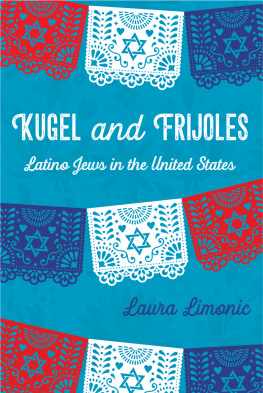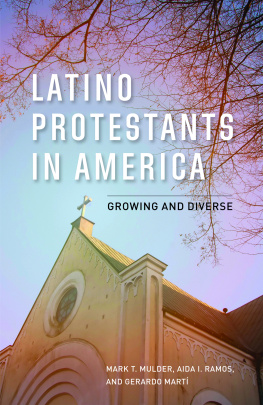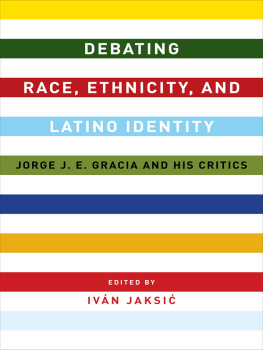
Kugel and Frijoles
Kugel and Frijoles
Latino Jews in the United States
Laura Limonic

Wayne State University Press
Detroit
2019 by Wayne State University Press, Detroit, Michigan 48201. All rights reserved. No part of this book may be reproduced without formal permission. Manufactured in the United States of America.
ISBN 978-0-8143-4576-4 (paperback)
ISBN 978-0-8143-4575-7 (hardcover)
ISBN 978-0-8143-4577-1 (e-book)
Library of Congress Control Number: 2018957223
Wayne State University Press
Leonard N. Simons Building
4809 Woodward Avenue
Detroit, Michigan 48201-1309
Visit us online at wsupress.wayne.edu
Contents
I HAVE BEEN IMMENSELY fortunate to have a host of mentors who guided me through this endeavor from its nascent stages through completion. Nancy Foner encouraged me to pursue this project from the first meeting I had with her early in my graduate school career. Without her mentorship, her brilliant guidance, and her support throughout all of these years, this project would not have come to fruition. I am grateful to both Phil Kasinitz and Richard Alba, who would allow me to walk into their offices unannounced to discuss theoretical perspectives and glean oceans of insight. Bill Helmreichs expertise on the New York Jewish experience has been invaluable. Mary Clare Lennon has been a beacon of support and guidance throughout this undertaking and beyond. I am deeply indebted to Laird Bergad, who hired me to work at the Center for Latin American, Caribbean, and Latino Studies (CLACLS) at the City University of New York (CUNY) during my first year of my doctoral program and who has, since then, become a trusted mentor and friend. Laird gave me a place within the CLACLS familia, which provided support, conversation, and intellectual stimulation. Thank you to Amalia Leguizamon who spent hours discussing and editing this manuscript. And thank you to my colleagues and students at SUNYOld Westbury, many of whom shared their own immigration stories with me.
This project was generously funded through a number of grants from CUNYs Graduate Center via the CLACLS and the Center for Jewish Studies. I was also fortunate to receive funding for this research from the Mandell L. and Madeleine H. Berman Foundation on two occasions.
I am grateful to the staff at Wayne State University Press: Ceylan Akturk, Emily Nowak, Carrie Teefey, and Rachel Ross. I would like to particularly thank Kathryn Wildfong who saw promise in this project from the beginning. Her enthusiasm and guidance were instrumental in the production of this book. Thank you to Jude Grant who provided keen and insightful copyediting.
I have benefited from many conversations with colleagues and mentors throughout the years, and their insights have made their way into the pages of this book. Judit Bokser Liwerant, Samuel G. Freedman, Matt Boxer, Bernadette Ludwig, Yolanda Martin, Max R. Greenberg, Charles Kadushin, and Samuel Heilman have all in some way helped me shape or fine-tune the ideas in this book. Thank you to my reviewers for their careful reading, comments, and suggestions, all of which considerably improved the book. I was fortunate to be part of the Association for Jewish Studies Paula Hyman Mentorship program and to be paired with Helen Kim, who has provided unparalleled advice and support as well as scholarly input.
I am deeply grateful to my parents, Alberto and Raquel Limonic, who were the inspiration for this project. Watching them forge an identity in a new country and straddle different worlds led me to ask the questions that drove this research. My brother, Fernando Limonic, and my sister-in-law, Jenne Wax, have been a tremendous source of support and encouragement.
As a mother of young children, I relied on my friends and family in immeasurable ways. Countless friends and family members have supported me along the way with phone calls, encouraging texts, meals, child-care help, and discussions. In alphabetical order: Carolina Azar, Lucila Broide, Alexis Carter, Adam Danzig, Marcela Donozo, David Ehrenberg, Kendra Falkenstein, Jose Fiocca, Dalia Gaer, Keisha Goode, Monica Levavi, Rut Limonic, Buffy Maguire, Marlene Nordlinger, Tahneer Oksman, Christine Ostrowski, Ileana Ratinoff, Tara Sansone, Haley Siman, Michelle Ticknor, Patricia Trachtenberg, and Jessie Yager.
To my run club, thank you for always helping me get to the finish line.
My husband, Francesco Brindisi, has been my greatest source of support throughout this endeavor. His intellectual curiosity and dedication to academic rigor have shaped my scholarly pursuits since our first coffee date on the sixth floor of the International Affairs Building. Our children, Alessandro and Annabella, have, in their own way, taught me that perseverance and hard work are the name of the game. And when that gets to be too much... there is never a bad time for a kitchen dance party.
And, of course, I would like to thank all of the respondents who generously gave of their time and shared their experiences with me. This book would not have been possible without you.
Introduction
I DONT UNDERSTAND. H OW can you be Jewish? Arent you Latina? How is it that you speak Spanish? I thought your family was Jewish?
Growing up in suburban Boston, an area with a large Jewish population, these sorts of questions came up often. It seemed odd to me, at the time, that people in the United States were unaware that Jewish communities exist in Latin America, especially since many of my classmates and I had common origins in the Eastern European shtetls, where many of our grandparents and great-grandparents hailed from. We shared many traditions and Jewish rites, though the seders at my familys home were often a cultural potpourri of Spanish, Hebrew, and English prayers, and the songs we sung at the end were as likely to be Argentine tangos as they were to be Yiddish folk songs. Friends from all over Latin America came to celebrate the Jewish holidays at our house, they came to partake in barbecues on Argentine Independence Day, and, of course, we always got together to watch the World Cup soccer matches every four years. We maintained ties to Argentina, traveling frequently, but over time, as we assimilated into our new country, my familys sense of place and identity became rooted in the United States. The fact is, however, our Argentine and Latin American roots as well as our Jewish heritage shaped our immigrant journey and structured how our assimilation in the United States transpired.
Incorporation and assimilation into a new country is accomplished through socioeconomic advances, language acquisition, or acculturation, and it also inevitably involves changes in ethnic identity. Indeed, immigrant incorporation into the United States is shaped by the ethnic and racial stratification system in this countryand how immigrants fit into the ethnic and racial landscape affects their life chances. A number of questions surround these issues: How do immigrants navigate the different ethnic and racial categories in the United States? How is insider status within existing racial and ethnic groups achieved? How does membership in ethnic and racial groups influence life chances? And to what extent are immigrants able to define their own
Jewish immigrants from Latin America are a particularly interesting group for such a study because they are not easily classified within the US racial and ethnic system and existing ethno-racial categories. They inhabit two worlds, that of Latinos, who are generally seen as nonwhite in the United States, and that of Jews, who are commonly viewed as white.whether these Latin American immigrants are classified primarily as Jewish and therefore white or whether, and in what situations, their national identities as Argentine, Mexican, or Venezuelan trump their Jewish ethnic identity. Another critical question is whether Jewish immigrants from Latin America are readily accepted into the Latino communities and/or if they consider themselves Latinos. A further complication is that Jews from Latin America are often considered ethno-religious minorities in their home countries. Like other Latinos in the United States, Latino Jews invoke different identities (e.g., national, religious, or panethnic) in response to different actors and situations (Itzigsohn & Dore-Cabral, 2000). While the ethnic label a person identifies with is shaped by outside forces that limit his or her choices, the agency a person has over these choices varies across racial and ethnic groups (Nagel, 1994). Since ethnic identification is situational, how members of a group identify depends on whom they are interacting with and how their ethnic identification influences the outcome of a particular situation.
Next page






